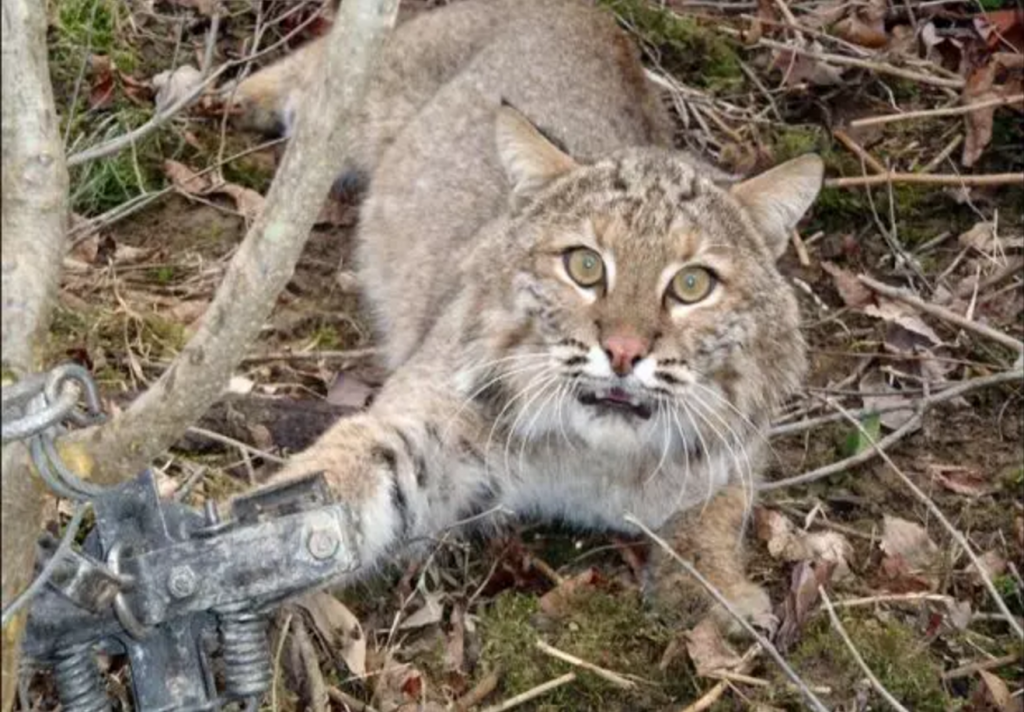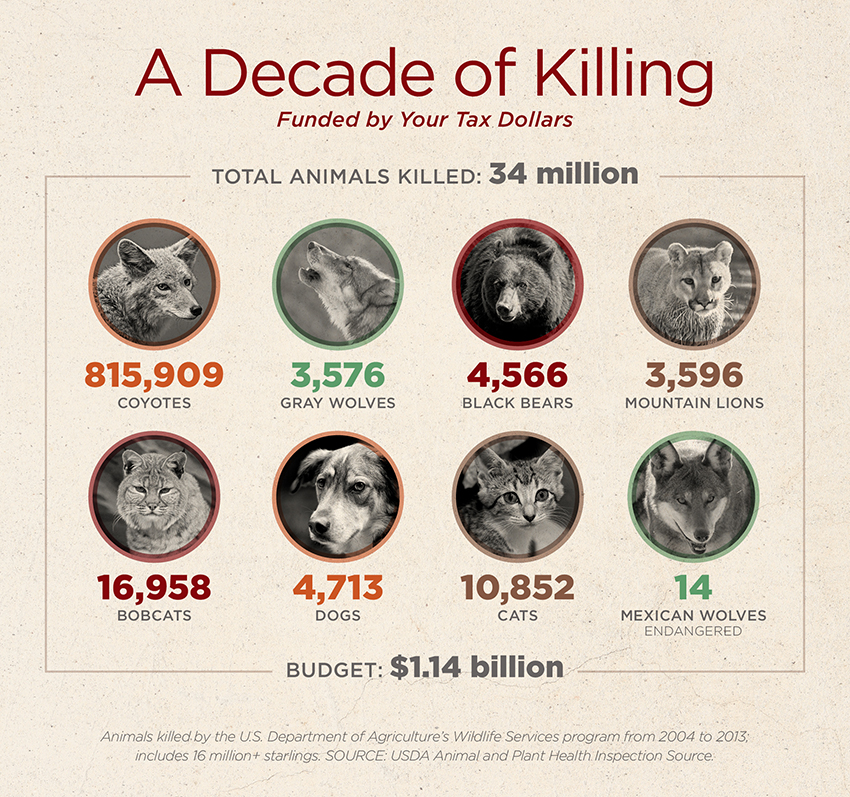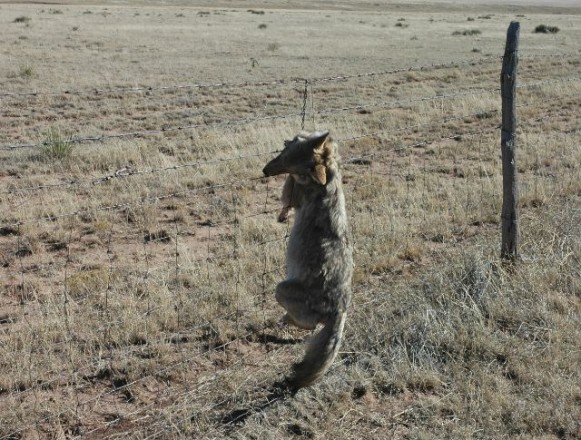‘Secret’ Federal Agency Admits Killing 3.2 Million Wild Animals in U.S. Last Year Alone

(EnviroNews DC News Bureau) — Washington D.C. — The United States Department of Agriculture’s (USDA) Wildlife Services (WS) admitted in its annual Program Data Report to having killed at least 3.2 million wild animals in 2015 alone — many of which were large predators. 1,681,283 of that total were animals native to the United States.
Environmental groups are already sounding the alarm, pointing out most of the exterminations were “at the behest of the agriculture and livestock industries.”
Former employees have also blown the whistle, claiming that a large number of the agency’s killings are not reported at all, leading many to to wonder if the actual amount of animals axed last year is far higher than the 3.2 million admitted — and that number has many conservationists and animal rights activists up in arms as it is.
As for predatory animals, coyotes took the worst of the program’s assault, with 69,905 specimens killed. Add those to the 384 gray wolves, 284 cougars, 480 black bears, 731 bobcats, 1,511 gray foxes and 1,534 red foxes, and it starts to resemble a taxpayer-funded predator-bloodbath. 20,334 black-tailed prairie dogs, 21,557 beavers, and hundreds of other species also fell victim to the program’s traps, bullets, snares and poisons. Even 17 domesticated dogs met their end at the hands of WS employees.

But surprisingly, it was birds that were hardest hit, with hundreds of thousands being taken out by the program — all with hard-earned tax dollars of course (at least if you are a U.S. citizen).
European starlings (Sturnus vulgaris) topped the list with 1,290,806 eliminated. Red-winged blackbirds (Agelaius phoeniceus) and brown-headed cowbirds (Molothrus ater) came in second and third with 708,486 and 475,905 being killed respectively in those two species — two species that travel together and interact with livestock. Common grackles (Quiscalus quiscula) congregate with the blackbirds and cowbirds, and 134,741 in that species were eradicated as well.
Wildlife Services is part of the USDA’s Animal and Plant Health Inspection Service (APHIS) and claims its mission is to “provide federal leadership and expertise to resolve wildlife conflicts to allow people and wildlife to coexist” — but conservation groups don’t see the program’s mission that way at all.
“Wildlife Services’ killing of native wildlife is scientifically baseless, ethically bankrupt, and fiscally foolish,” said Bethany Cotton, Wildlife Program Director at WildEarth Guardians. “Most Americans would be outraged to know that millions of dollars of their hard-earned money is spent on killing wildlife using cruel traps, snares, and aerial gunning.”
AS SECRETIVE AS SECRET GETS
It’s not just the headline on this story that refers to the nearly 100-year-old program as “secretive.” Earlier this year, National Geographic Magazine’s Rachael Bale started off a feature story on the agency this way:
Wildlife Services — ever heard of it? No, not the U.S. Fish and Wildlife Service. That’s something different. The Fish and Wildlife Service is part of the Department of the Interior, charged with enforcing wildlife laws, restoring habitat, and protecting fish, plants, and animals. Wildlife Services isn’t your state fish and game commission, either, which issues hunting and fishing licenses and manages local wildlife.
Wildlife Services is a federal agency under the U.S. Department of Agriculture, and it specializes in killing wild animals that threaten livestock—especially predators such as coyotes, wolves, and cougars. Outside the ranching community, few have heard of Wildlife Services.
Tom Knudson, a two-time Pulitzer Prize winning reporter who now writes for RevealNews.org, authored a 12-article set on WS for the Sacramento Bee. Knudson recently summed up the agency this way:
The odds are good you have never heard of a small federal agency that goes by the curious name of Wildlife Services.
There’s a reason for that. The agency – which specializes in killing wild animals that threaten agriculture, especially predators – prefers to operate in the shadows.
That is a lesson I learned repeatedly while reporting a series of articles about Wildlife Services for The Sacramento Bee in 2012. Even basic information about where species were killed – and with what methods – was closely guarded and accessible only via the Freedom of Information Act. When I asked to observe Wildlife Services’ lethal predator control in action on public land in Nevada, the answer was unequivocal: No.
Christopher Ketcham, a fellow at MIT’s Knight Science Journalism Program, wrote a bombshell report in Harper’s Magazine earlier this year on WS titled, “The Rogue Agency: A USDA program that tortures dogs and kills endangered species.” In an interview with NatGeo’s Wildlife Watch, Ketcham tells of his own experience with WS — and how the agency denied him at every turn:
Congressman Peter DeFazio would tell you that it’s unaccountable and secretive. He has tried to get information about its finances and its operations, and he couldn’t get it.
Wildlife Services seems to be freely violating their directives, especially when it comes to the EPA’s rules on the use of pesticides. They appear not to be operating with any kind of science-based system to justify their lethal control against wildlife. And when their own trappers are found to be committing what appear to be cruel and inhumane acts against wildlife, nothing happens to those trappers.
These are not people who are forthcoming about information. I spent a year working on this story, and contacted Wildlife Services multiple times to ask to go out in the field with a trapper to observe their lethal control operations. They never granted me that request, claiming it would endanger me. Then I sent them a list of 35 questions, almost none of which were directly answered. If they’re not going to a respond to an informational request from a senior congressman in the House, do you think they’re going to answer a reporter?
WILDLIFE DISSERVICES?
The Humane Society refers to the program as “Wildlife Disservices,” and released a graph (now three years old) highlighting the millions of wild creatures wiped out by the federal government in the name of predator control.

The Humane Society also points out WS spent in excess of a billion taxpayer dollars over a decade to, “[kill] nearly 34 million bears, bobcats, coyotes, mountain lions, wolves and many other wild animals in the name of protecting crops, farm animals, private property and even other species such as rare birds and prey species favored by hunters.”
Outrage has been growing with the federal government over WS for years — so much so that the environmental organization Predator Defense even made an award-winning documentary titled, EXPOSED — USDA’s Secret War on Wildlife.
But it’s not only the sheer volume of animals being killed that is bringing heat down on WS — it’s the way they’re being killed too. The program has been widely chastised for using exterminatory techniques that are cruel, outdated, unscientific and unnecessary. For example: In addition to gunning down coyotes and other predators from the air in a terrifying fashion, in other cases, cyanide pellets are ejected into the mouths of animals causing excruciating deaths. Litters of cubs or pups are gassed in their dens creating fallout for other species and the environment. At times animals remain hung up in traps or snares for hours or days before expiring.


The scientific soundness (or lack thereof) of WS’ killing methods is also under heavy fire. WildEarth Guardians explained in its press release, “The best science shows that when coyotes are killed, especially the alpha males and females, the remaining subordinate population breeds more to compensate, which increases the likelihood of human-wildlife conflict. Similarly, when wolves are indiscriminately killed, the pack structure is destabilized and the likelihood of conflicts with livestock increases. Killing these animals destabilizes the self-regulating intra and inter-pack dynamics of these species, exacerbating rather than solving alleged problems.”
Wildlife Services is being sued in several cases by WildEarth Guardians, Center for Biological Diversity, Predator Defense, Western Watersheds Project, Friends of the Clearwater and others. Most recently, a lawsuit was filed against the agency for its indiscriminate, excessive and unscientific killing of wolves in Idaho.
Another suit was also filed against WS by the same groups for killing unreasonably high numbers of wild animals in Idaho, and for failing to perform an adequate environmental impact assessment regarding how its killing activities affect the ecosystem at large.
The aforementioned coalition of environmental organizations has a historically high success rate against the federal government in court on wildlife cases. It remains to be seen whether the courts will side with environmentalists again in these cases.
Five Environmental Groups Sue USDA Over Idaho Wolf-Killing Program
(EnviroNews Idaho) – Boise, Idaho – On June 1, 2016, five prominent environmental organizations filed a lawsuit in federal district court against the United States Department of Agriculture’s (USDA) Wildlife Services for killing over 650 wolves in the state of Idaho over the past decade. Wildlife Services…
FILM AND ARTICLE CREDITS
- Emerson Urry - Journalist, Author


![Leading the Charge for America’s Wild Horses on Capitol Hill: NBA/NFL Celeb. Bonnie-Jill Laflin: ‘[Politics] won’t stop us from fighting’](https://cf-images.us-east-1.prod.boltdns.net/v1/static/1927032138001/f46b2158-cead-47f0-ab44-4b027059411a/4e4afcf2-937d-4a9d-acba-1b82e2efd4c6/160x90/match/image.jpg)


